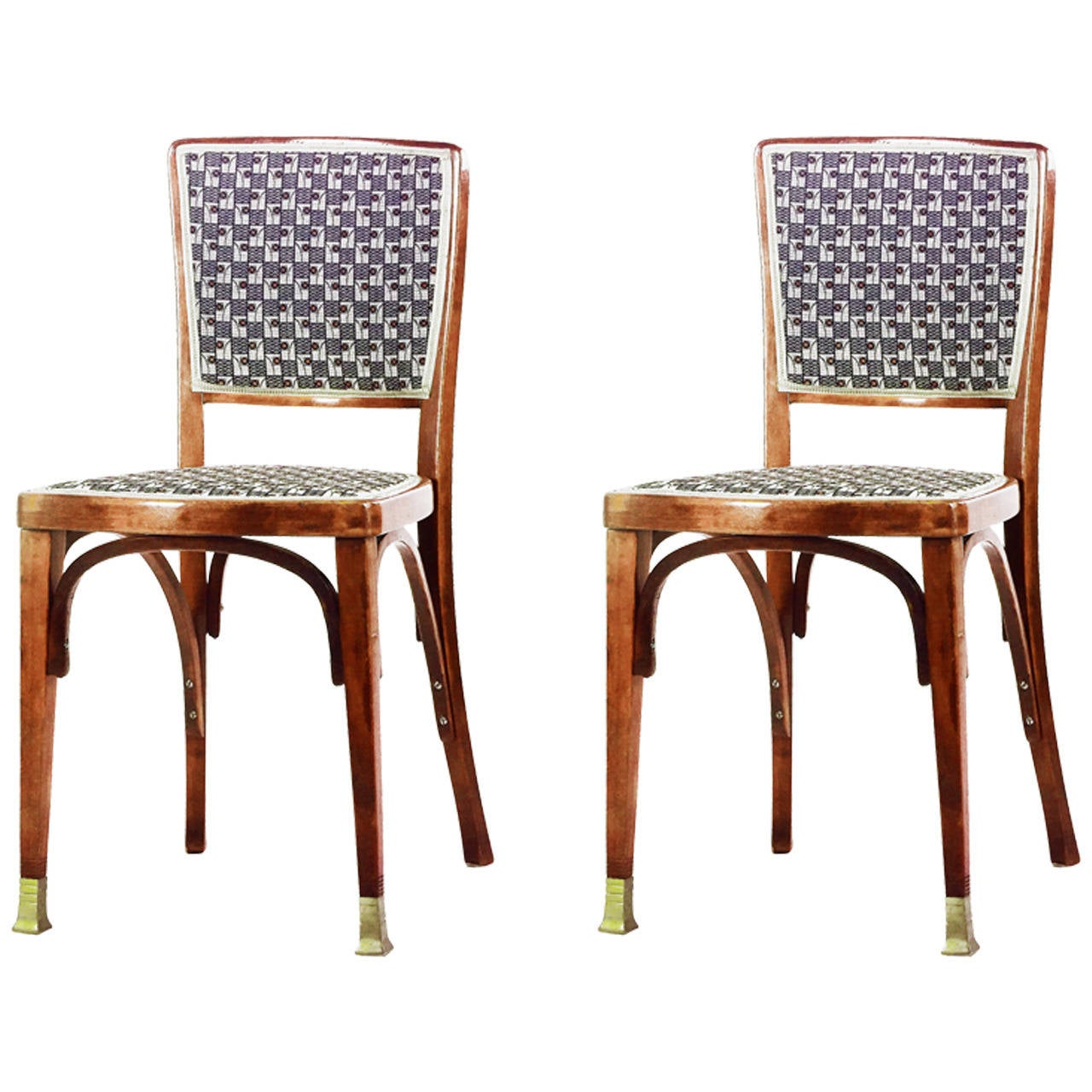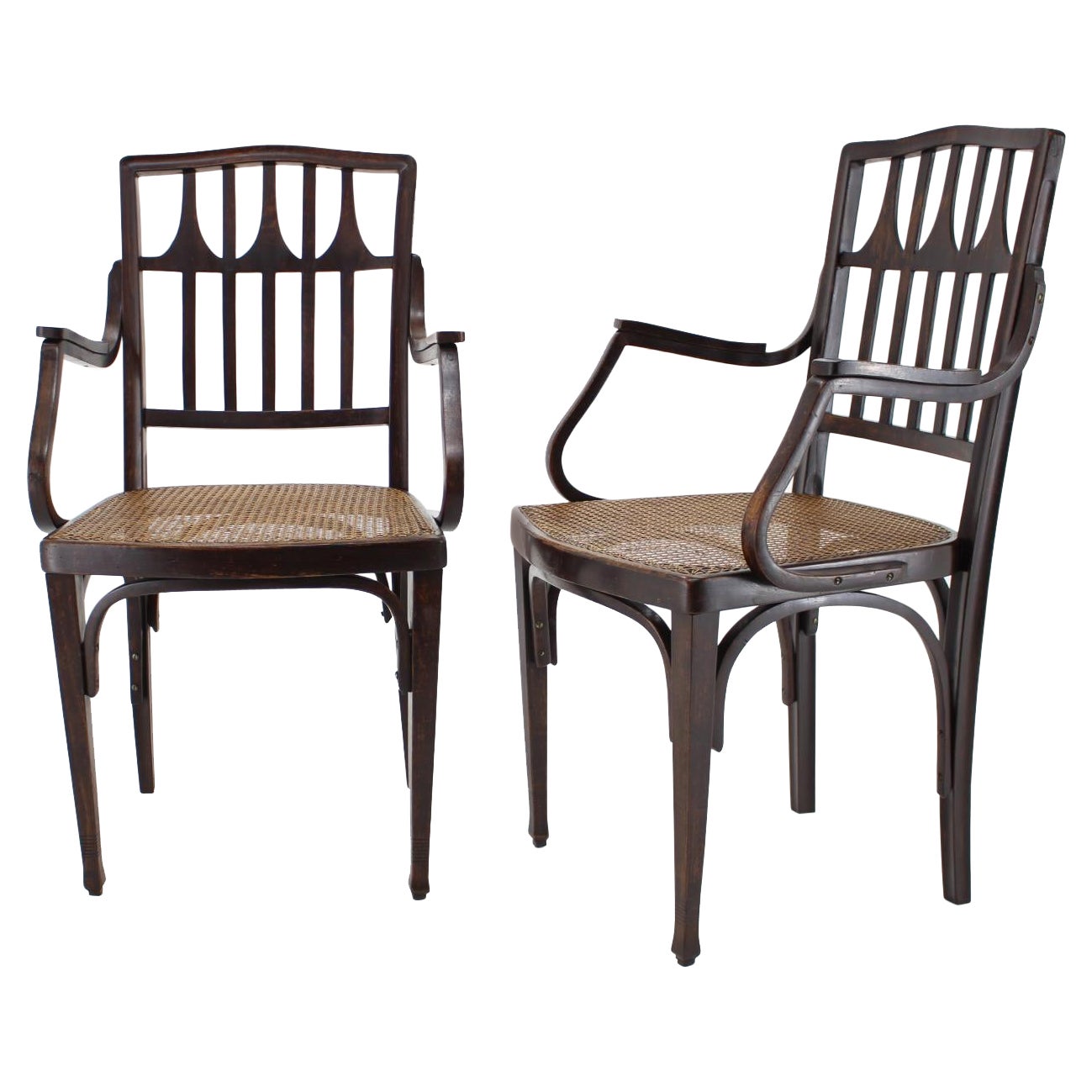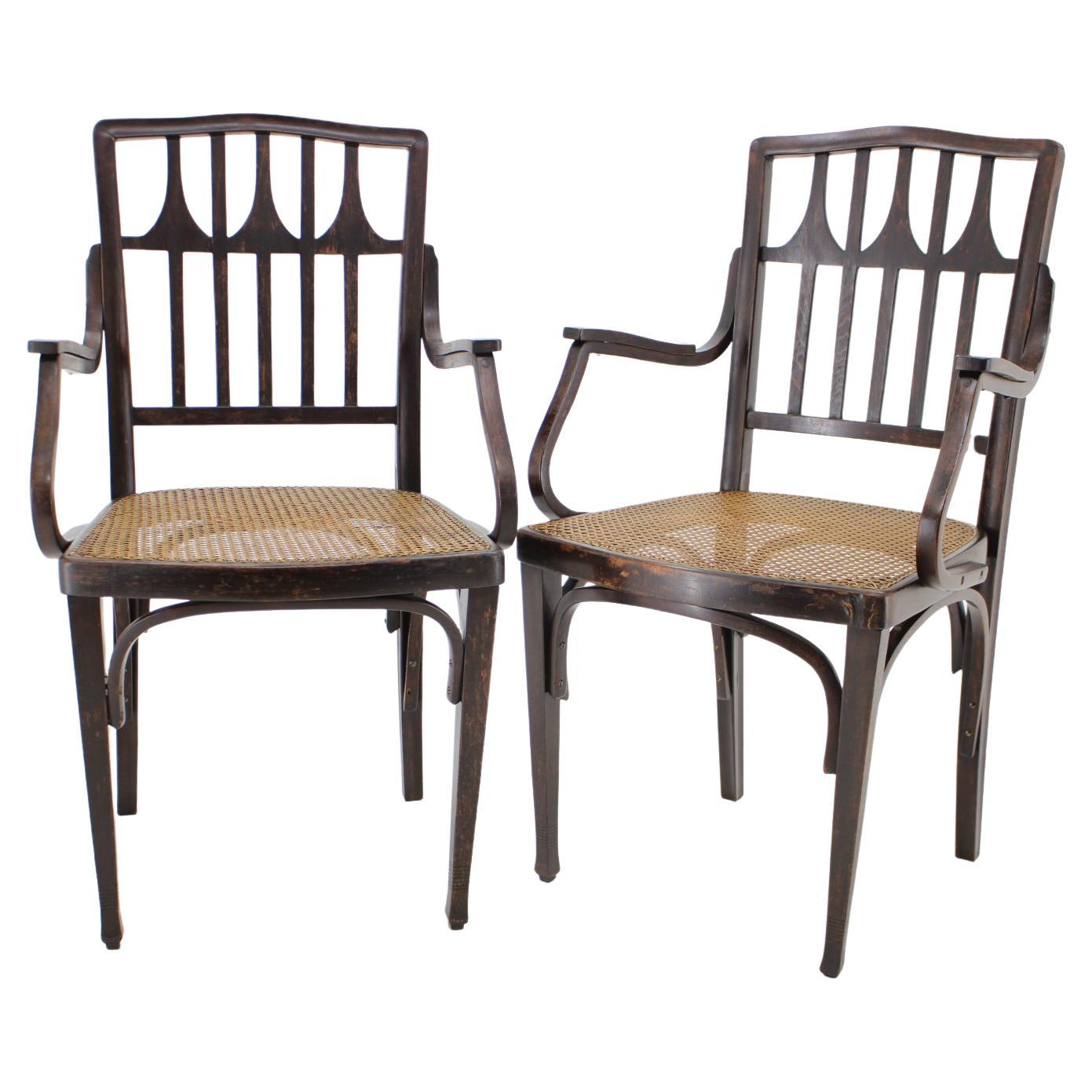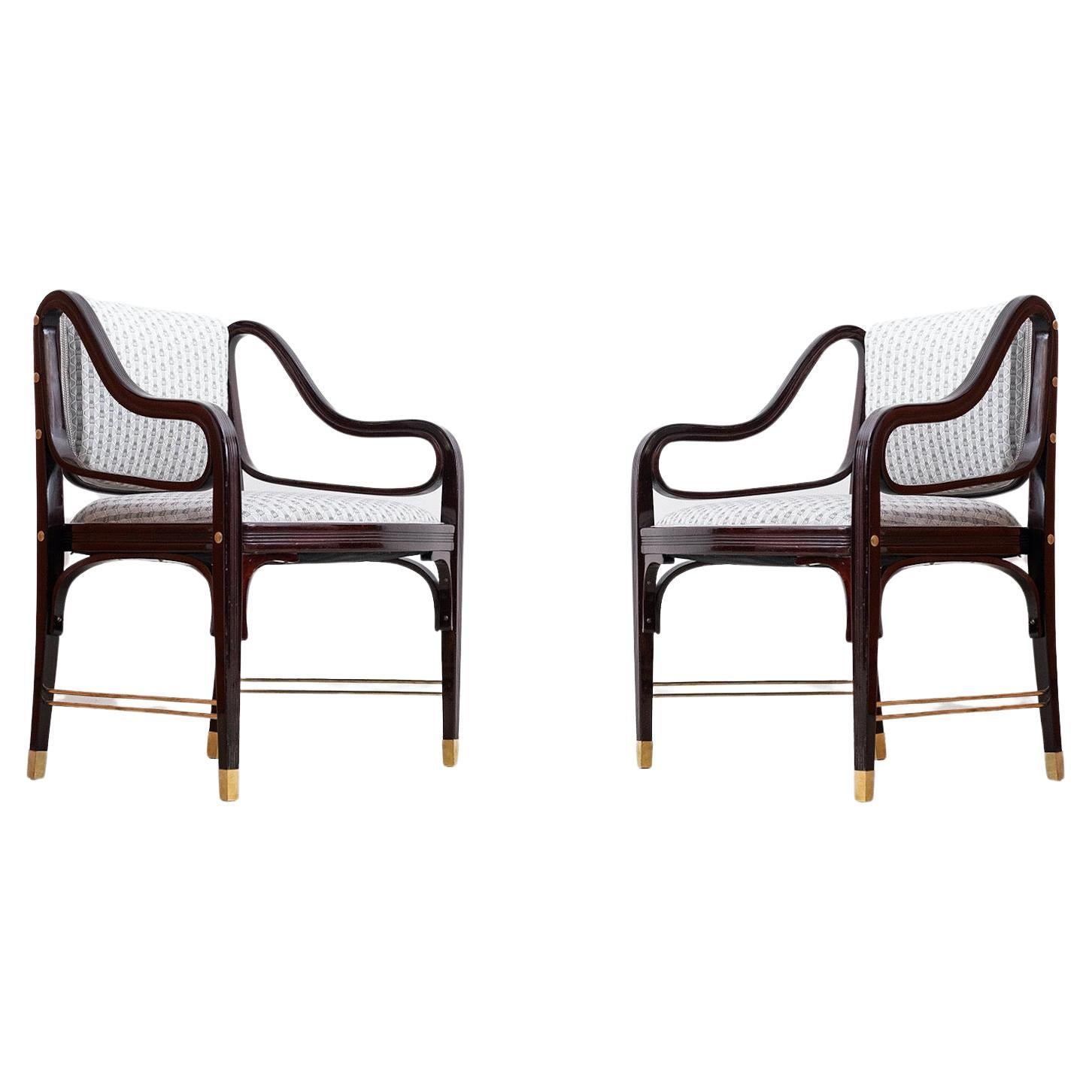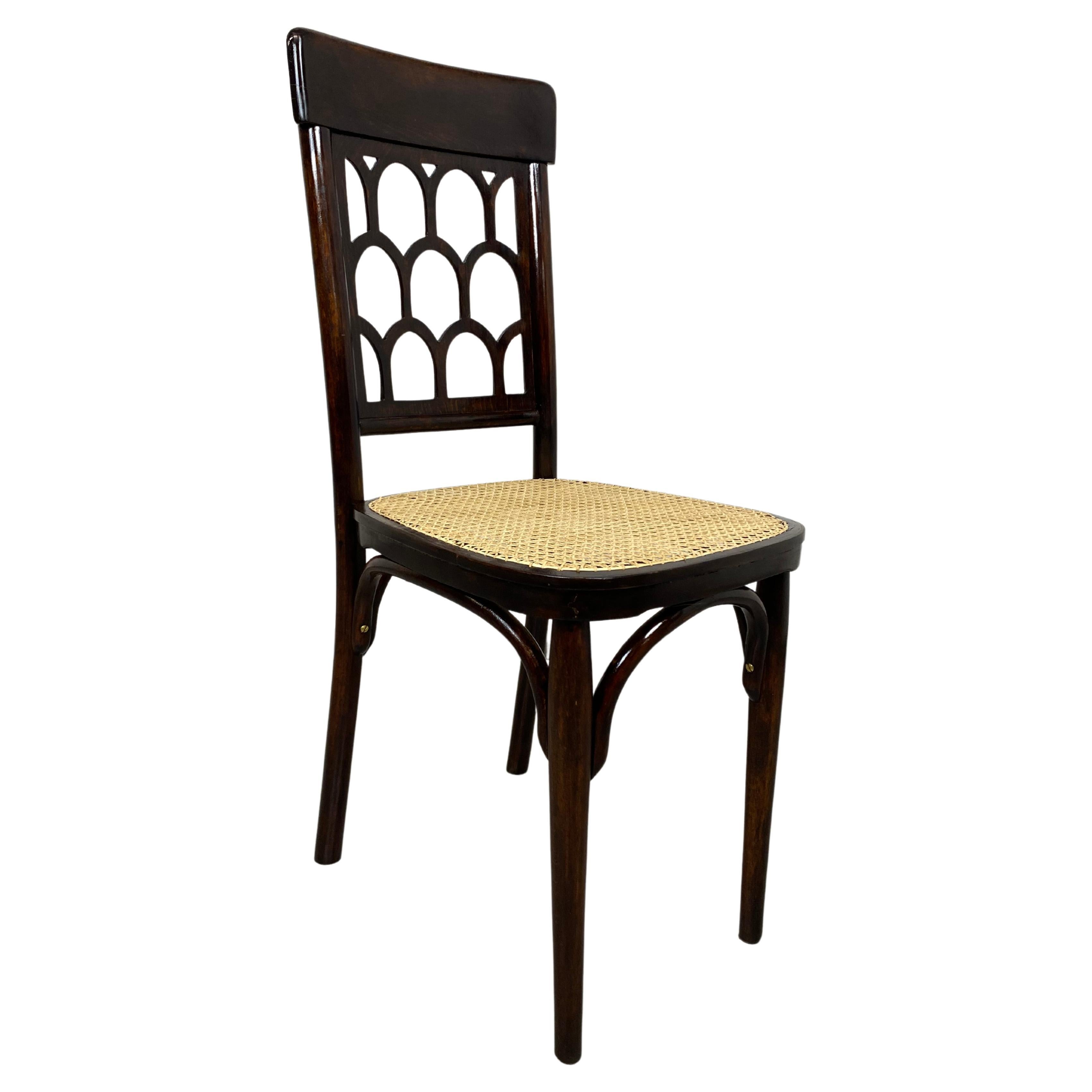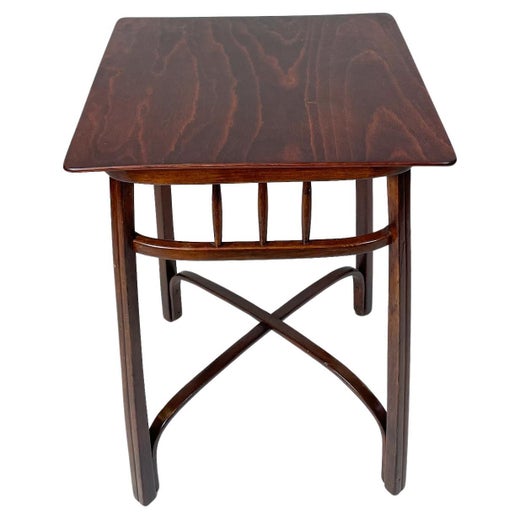Jugendstil armchair 719F by Koloman Moser for J&J Kohn
About the Item
- Creator:Koloman Moser (Designer),Jacob & Josef Kohn (Manufacturer)
- Dimensions:Height: 34.26 in (87 cm)Width: 20.87 in (53 cm)Depth: 19.69 in (50 cm)Seat Height: 18.51 in (47 cm)
- Style:Jugendstil (Of the Period)
- Materials and Techniques:
- Place of Origin:
- Period:1910-1919
- Date of Manufacture:1910s
- Condition:Reupholstered. Refinished. Wear consistent with age and use.
- Seller Location:Banská Štiavnica, SK
- Reference Number:1stDibs: LU6444236210962
Koloman Moser
Born in Vienna in 1868, Koloman Moser briefly attended trade school, honoring his father’s wish to see him in commerce. But he soon surrendered to his artistic inclinations, enrolling in 1885 in Vienna’s Academy of Fine Arts, where he studied painting.
When his father died unexpectedly in 1888, leaving the family in financial straits, Moser (1868–1918) helped out by doing illustrations for books and magazines. Meanwhile, he continued his painting studies, at the academy and then at the School of Arts and Crafts, starting in 1892. That was also the year that Moser, along with other young artists revolting against the Viennese art world’s devotion to naturalism, formed the Siebner Club, the precursor to the Vienna Secession.
Moser’s introduction during his last term at school to Gustav Klimt’s Allegory of Sculpture proved a turning point for the young artist. Christian Witt-Dörring, guest curator of the 2018–19 exhibition “Koloman Moser: Universal Artist between Gustav Klimt and Josef Hoffmann” at the MAK in Vienna, noted a change in the artist’s drawing style. “Primarily inspired by the art of Japan, [Klimt] introduces new paper sizes, fragmented image details, and an emphasis on the line as opposed to the surface,” wrote Witt-Dörring in the exhibition’s catalogue.
A year later, in 1897, Moser together with Klimt, Carl Moll, Joseph Olbrich and Josef Hoffmann founded the Vienna Secession, a union of artists and designers determined to upend Austria’s artistic conservatism. The members were committed to making total works of art: Gesamtkunstwerken. Looking to the English Arts and Crafts Movement, with its guiding principle of unity of the arts, the group attempted to bring art back into everyday life and introduce a local modernism to fin-de-siècle Vienna. Moser, whose membership in the club also afforded him entry into upper-class Viennese society, turned his back on oil painting and forged ahead with Gesamtkunstwerk.
Moser created everything from exhibition design to facade ornamentation for the Secession Building, to graphic materials. Moser also produced posters and advertisements in his “modern style” for various companies. In 1898, he presented his first decor pieces, including hand-knotted rugs and cushion covers. In 1899, Moser began what would become a lifelong professorship at the School of Arts and Crafts. His repertoire now expanded to include furniture, ceramics and patterns like his trademark checkerboard design. He also moved into scenography and fashion and established himself as an interior designer.
The artist decorated his own home in 1902, after which he received a series of important commissions, notably the villa of textile industrialist Fritz Waerndorfer. It was Waerndorfer who provided the financial support that enabled Moser and Hoffmann in 1903 to found the Wiener Werkstätte, a platform for fully realizing their ideal of Gesamtkunstwerk. Two years later, Moser married Edith Mautner von Markhof, the daughter to one of Austria’s great industrial barons, and his work thrived.
In 1907, the Wiener Werkstätte ran into financial trouble. Losing faith in the unity of the arts and disillusioned with the group’s dependency on wealthy patrons like Waerndorfer, Moser left the Werkstätte. He returned to his original discipline, painting, which he continued to practice until his untimely death from cancer, in 1918.
Today, Koloman Moser’s work, from his metal vases to his jewelry to his interiors, remains sought-after and revered. Browse Moser's radically modern creations at 1stDibs.
Jacob & Josef Kohn
While the first name that comes to mind when thinking of bentwood furniture might be Thonet (maker of the iconic Thonet No. 14 chair or “bistro chair”), Michael Thonet and his subsequent studio, the Gebrüder Thonet (Thonet Brothers), had a strong competitor in 19th-century Vienna: Jacob & Josef Kohn (also referred to as J. & J. Kohn).
Founded in 1849 by a father and son with the motto “Be one step ahead,” Jacob & Josef Kohn created modern furniture for indoors and out from Austrian beech. At the turn of the 20th century, after establishing itself with mastery of everything from chairs to coatracks and even doll furniture, J. & J. Kohn began working closely with the Wiener Werkstätte, the artisan cooperative cofounded by Austrian architect and designer Josef Hoffmann (Gustav Klimt and Koloman Moser were also members). Through this partnership, J. & J. Kohn produced an array of furniture in bentwood, cane and upholstery, which it sold through showrooms across Europe and North America. Its designs throughout the first decade of the 20th century reflect the Art Nouveau movement that was quickly gaining traction across Europe.
Price wars and mergers ensued during the first World War, and a company that Jacob & Josef Kohn had merged with became part of the world’s largest furniture manufacturer in 1923. The new conglomerate went on to produce examples of its bentwood furniture in keeping with the modern style of the Vienna Secession. While Thonet rebuilt, rebranded and expanded in the United States and elsewhere after World War II, J. & J. Kohn never produced furniture under that name again.
Find a variety of J. & J. Kohn furniture — including bentwood wingback chairs designed by Josef Hoffmann, beech nesting tables and more — at 1stDibs.
- ShippingRetrieving quote...Ships From: Hronská Breznica, Slovakia
- Return PolicyA return for this item may be initiated within 14 days of delivery.
- Secession Desk Chair nr.327 by Koloman Moser for J.&J.KohnBy Jacob & Josef Kohn, Koloman MoserLocated in Banská Štiavnica, SKSecession desk chair nr.327 by Koloman Moser for J.&J.Kohn.Category
Vintage 1910s Austrian Vienna Secession Office Chairs and Desk Chairs
MaterialsBeech
- Secession beehive chair by Koloman Moser for J&J KohnBy Jacob & Josef Kohn, Koloman MoserLocated in Banská Štiavnica, SKSecession beehive chair by Koloman Moser for J&J Kohn. New handmade rattan seat, professionally stained and repolished.Category
Antique Early 1900s Austrian Vienna Secession Dining Room Chairs
MaterialsRattan, Beech
- Magazine holder no.1069 by Koloman Moser for J&J KohnBy Jacob & Josef Kohn, Koloman MoserLocated in Banská Štiavnica, SKMagazine holder no.1069 by Koloman Moser for J&J Kohn in very nice original condition with signs of use.Category
Vintage 1910s Austrian Vienna Secession Magazine Racks and Stands
MaterialsBeech, Bentwood
- Jugendstil brass chandelier by Koloman MoserBy Koloman MoserLocated in Banská Štiavnica, SKJugendstil brass chandelier by Koloman Moser in excellent condition.Category
Antique Early 1900s Austrian Jugendstil Chandeliers and Pendants
MaterialsBrass
- Secession Mirror No.1149 by Koloman Moser for Jacob & Josef KohnBy Jacob & Josef Kohn, Koloman MoserLocated in Banská Štiavnica, SKSecession mirror no.1149 by Koloman Moser for Jacob & Josef Kohn. Very rare model. Professionally stained and repolished.Category
Antique Early 1900s Austrian Vienna Secession Floor Mirrors and Full-Len...
MaterialsBentwood
- Jugendstil armchairs by J&J KohnBy Jacob & Josef KohnLocated in Banská Štiavnica, SKJugendstil armchairs by J&J Kohn in original condition with signs of use.Category
Antique Early 1900s Austrian Jugendstil Armchairs
MaterialsBeech, Bentwood
- Pair of Kohn Chairs No. 719 Attributed to Koloman MoserBy Koloman Moser, Jacob & Josef KohnLocated in Vienna, ATPair of Vienna Seccesion chairs by Kohn (model no. 719) attributed to Koloman Moser. Chairs are unrestored and the restoration can be made on request Beech, bentwood, mahogany/nut ...Category
Early 20th Century Austrian Vienna Secession Side Chairs
MaterialsBrass
- 1900s Koloman Moser Pair of Armchairs for J & J Kohn No. 327By Koloman Moser, Jacob & Josef KohnLocated in Praha, CZ-good original condition -carefully restored and finished with shellac -seat strings in good condition..reforced in some places.Category
Antique 19th Century Austrian Art Nouveau Armchairs
MaterialsWood
- 1900s Koloman Moser Pair of Armchairs for J & J Kohn No. 327By Koloman Moser, Jacob & Josef KohnLocated in Praha, CZ-good original condition -carefully restored and finished with shellac -seat strings in good condition..reforced in some places -height of seat 48 cm.Category
Antique 19th Century Austrian Art Nouveau Armchairs
MaterialsWood
- 2x Secessionistic armchairs by Koloman Moser/Otto Wagner for J.&J. KohnBy Otto Wagner, Koloman Moser, Jacob & Josef KohnLocated in Wien, ATObjekt: Armlehnstuhl (2 Exemplare vorhanden) Entwurf: Koloman Moser (Wien, um 1900) oder Otto Wagner (Wien, um 1901) Modell-Nummer: 412 Ausführung: Jacob & Josef Kohn (Wien, um 1902) Maße in cm (H x B x T): 80 x 60 x 58 Material: Buchen-Bugholz (palisander gebeizt & Schellack handpolitiert), Messing, Stoff (Backhausen, Windlichter - „M6185C08" - Entwurf von Ernst Lichtblau...Category
Antique Early 1900s Austrian Vienna Secession Armchairs
MaterialsBrass
- Pair of Austrian Secessionist Side Armchairs by Koloman Moser for J & J KohnBy Koloman Moser, Jacob & Josef KohnLocated in New York City, NYA fine pair of Austrian Secessionist bentwood chairs for a salon / living room, office, bedroom, foyer... in walnut stained beechwood with upholstered seat and back. Designed by Koloman Moser: March 30, 1868 – October 18, 1918 Manufactured by J & J Kohn in 1910 Geometric arms and square back rests complement the sweeping curved surround featuring horizontal slat design which decorates the chair backs. Austere planes and strict geometry typical of the Wiener Werkstätte are featured on this pair of armchairs. Elegantly curved and straight edged wooden elements provide Stark architectural planes, timelessness, comfort and beauty. The set's upholstery was from Backhausen, the famous, high end textile house that has been in business since 1849 and made fabric for these original designers during the period. Moser was an important designer. He was a founding members and artistic director of the Jugenstil art movement. Along with Josef Hoffman, Moser co founded the iconic Wiener Werkstätte ( Viennese workshop) . The Wiener Werkstätte was a workshop dedicated to the production of craftwork. Art Deco armchairs, Club Chairs, bergere chairs, canapes, chairs, chaise longues, club chairs, corner chairs, daybeds, living room sets, Dining Room Chairs, Lounge Chairs, Office Chairs and Desk Chairs...Category
Early 20th Century Austrian Vienna Secession Armchairs
MaterialsBentwood
- Koloman Moser pair of armchairs mod. 719 with expertiseBy Koloman MoserLocated in Firenze, FIA pair of armchairs 1902s mod. 719 with expertise from BEL ETAGE gallery Wien. Made from J & J Kohn. Materials: beech and brass. This armchair have been ...Category
Antique Early 1900s Austrian Armchairs
MaterialsBeech

